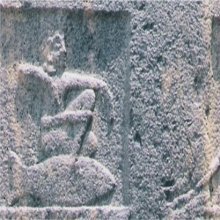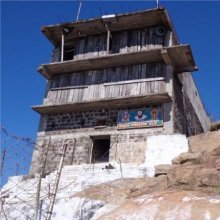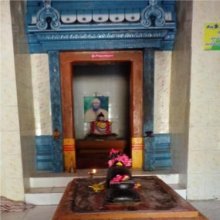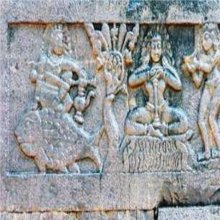Mallikarjuna, Mallikārjuna, Mallika-arjuna: 16 definitions
Introduction:
Mallikarjuna means something in Hinduism, Sanskrit, the history of ancient India, Marathi. If you want to know the exact meaning, history, etymology or English translation of this term then check out the descriptions on this page. Add your comment or reference to a book if you want to contribute to this summary article.
Images (photo gallery)
In Hinduism
Vastushastra (architecture)
Source: Shodhganga: Temples of Salem region Up to 1336 ADMallikārjuna (मल्लिकार्जुन).—In the elevation, Mallikārjuna temple possesses an adhiṣṭhāna, bhitti, prastara and śikhara. The temple is built out of stone except for the śikhara, which is replaced now. The adhiṣṭhāna is sub-merged in the modern flooring of the courtyard as a result of renovations. On the outer wall, to the left of the garbhagṛha, koṣṭas housing the images of Brahmā and Durga are noticed. The height of these images is about one foot tall. They have an archaic look, but they are highly eroded. The Durga image in this kosta, resembles the one found in the gūḍhamaṇḍapa of the Kamakshi-Amman temple.

Vastushastra (वास्तुशास्त्र, vāstuśāstra) refers to the ancient Indian science (shastra) of architecture (vastu), dealing with topics such architecture, sculpture, town-building, fort building and various other constructions. Vastu also deals with the philosophy of the architectural relation with the cosmic universe.
Vaishnavism (Vaishava dharma)
Source: Prabhupada Books: Sri Caitanya CaritamrtaMallikārjuna (मल्लिकार्जुन).—According to Śrī Caitanya Caritāmṛta, Madya-lila 9.15, “Śrī Caitanya Mahāprabhu then went to Mallikārjuna-tīrtha and saw the deity of Lord Śiva there. He also induced all the people to chant the Hare Kṛṣṇa mahā-mantra”. Mallikārjuna is also known as Śrī Saila. It is situated about seventy miles south of Karṇula on the right bank of the Kṛṣṇā River. There are great walls all around the village, and within the walls resides the deity known as Mallikārjuna. It is a deity of Lord Śiva and is one of the Jyotirliṅgas.

Vaishnava (वैष्णव, vaiṣṇava) or vaishnavism (vaiṣṇavism) represents a tradition of Hinduism worshipping Vishnu as the supreme Lord. Similar to the Shaktism and Shaivism traditions, Vaishnavism also developed as an individual movement, famous for its exposition of the dashavatara (‘ten avatars of Vishnu’).
Purana and Itihasa (epic history)
Source: archive.org: Shiva Purana - English TranslationMallikārjuna (मल्लिकार्जुन) is the name of a Jyotirliṅga, according to the Śivapurāṇa 2.4.20 (“The celebration of Gaṇeśa’s marriage”).—Accordingly, after Kārttikeya went to the Krauñca mountain: “[...] Pārvatī became grief-stricken by separation from Skanda. She piteously told her lord—‘O lord, let us go there’. Śiva went to that mountain partially for her happiness. He assumed the pleasing form of Jyotirliṅga named Mallikārjuna. Even now Śiva is seen there with Pārvatī satisfying the desires of his devotees. He is the goal of the good. [...]”.
Note: Mallikārjuna or Śrīśaila refers to one of twelve Jyotirliṅgas, according to the Śivapurāṇa 1.22 while explaining the importance of the partaking of the Naivedya of Śiva. Mallikārjuna is located at on a mountain near the river Kṛṣṇā.—According to the present context [of chapter 2.4.20] the Mallikārjuna Jyotirliṅga was established on the Krauñca mountain. It is difficult to know how it came to be identified with the one on Śrīśaila overhanging the Kṛṣṇā river in the south.

The Purana (पुराण, purāṇas) refers to Sanskrit literature preserving ancient India’s vast cultural history, including historical legends, religious ceremonies, various arts and sciences. The eighteen mahapuranas total over 400,000 shlokas (metrical couplets) and date to at least several centuries BCE.
India history and geography
Source: archive.org: Chaitanya’s life and teachings (history)Mallikarjun is one of the places visited by Chaitanya during his pilgrimage in Southern India between April 1510 and January 1512.—Mallikarjun.—Shri-Shailam, on the south bank of the Krishna, 70 miles below Karnul. In the centre of the enclosure is the temple of Mallikarjun Shiva, the chief deity worshipped here, and considered as one of the jyotir-lingas. (Kurnool Manual, 181-183, 144). There is another and much less famous temple to Mallikarjun at Bezvada on the Krishna river.
Source: Archaeological Survey of India: Śaiva monuments at PaṭṭadakalMallikārjuna (मल्लिकार्जुन) is the name of a shrine built by Trailokyamahādevī and Lokamahādevī, both queens of Vikramāditya and belonging to the Haihaya family. The shrine was previously known as Trailokyeśvara. Vikramāditya II was the son of Vijayaditya, son of Vinayaditya, son of Vikramāditya I.
Mallikārjuna is one of the eight temples located in a space to the north of the village Paṭṭadakal, arrayed in a rectangle of about 180 x 140 m on the western bank of the river.
Source: What is India: Inscriptions of the ŚilāhārasMallikārjuna (fl. 1154 A.D.) is the name of a king from the Śilāhāra dynasty, according to the “British museum stone inscription of the reign of Haripāladeva”.
This stone inscription (mentioning Mallikārjuna) was apparently found somewhere is North Koṅkaṇ and is now deposited in the British Museum, London. It records that some miscreants did damage to the channel (nāḍa) near a well belonging to the residents of the village Turubhāmra and dedicated to the god Agnihotra. It is dated in Śaka 1076, the cyclic year Bhāva and the full-moon tithi of Māgha.
Source: Shodhganga: Kakati Ganapatideva and his timesMallikārjuna (मल्लिकार्जुन) is the name of a Telugu poet active during the reign of Gaṇapatideva-mahārāja (r. 1199-1262 A.D.) The political unity, the economic prosperity and growth of Telugu literature created and promoted national consciousness among the Āndhras which found its echos in the literary compositions of this period.

The history of India traces the identification of countries, villages, towns and other regions of India, as well as mythology, zoology, royal dynasties, rulers, tribes, local festivities and traditions and regional languages. Ancient India enjoyed religious freedom and encourages the path of Dharma, a concept common to Buddhism, Hinduism, and Jainism.
Languages of India and abroad
Marathi-English dictionary
Source: DDSA: The Molesworth Marathi and English Dictionarymallikārjuna (मल्लिकार्जुन).—m S One of the twelve lingams of Shiva. See bārā jyōtiliṅga.
Source: DDSA: The Aryabhusan school dictionary, Marathi-Englishmallikārjuna (मल्लिकार्जुन).—m One of the twelve lingams of śiva.
Marathi is an Indo-European language having over 70 million native speakers people in (predominantly) Maharashtra India. Marathi, like many other Indo-Aryan languages, evolved from early forms of Prakrit, which itself is a subset of Sanskrit, one of the most ancient languages of the world.
Sanskrit dictionary
Source: DDSA: The practical Sanskrit-English dictionaryMallikārjuna (मल्लिकार्जुन).—Name of a Liṅga of Śiva on the mountain Śrīśaila.
Derivable forms: mallikārjunaḥ (मल्लिकार्जुनः), mallikārjunaḥ (मल्लिकार्जुनः).
Mallikārjuna is a Sanskrit compound consisting of the terms mallika and arjuna (अर्जुन).
Source: Cologne Digital Sanskrit Dictionaries: Aufrecht Catalogus Catalogorum1) Mallikārjuna (मल्लिकार्जुन) as mentioned in Aufrecht’s Catalogus Catalogorum:—guru of Veṅkaṭa (Śabdārthakalpataru 1806 -10). Oxf. 196^b.
2) Mallikārjuna (मल्लिकार्जुन):—Sūryasiddhāntaṭīkā.
Source: Cologne Digital Sanskrit Dictionaries: Monier-Williams Sanskrit-English Dictionary1) Mallikārjuna (मल्लिकार्जुन):—[from mallikā > malla] a See under mallika.
2) [from mallika] b m. a form of Śiva (n. Name of a Liṅga consecrated to Śiva on the Śrī-śaila), [Vāsavadattā]
3) [v.s. ...] of an author, [Catalogue(s)]
4) [v.s. ...] of the Guru of Veṅkaṭa, [ib.]
Source: DDSA: Paia-sadda-mahannavo; a comprehensive Prakrit Hindi dictionary (S)Mallikārjuna (मल्लिकार्जुन) in the Sanskrit language is related to the Prakrit word: Malliajjuṇa.
[Sanskrit to German]
Sanskrit, also spelled संस्कृतम् (saṃskṛtam), is an ancient language of India commonly seen as the grandmother of the Indo-European language family (even English!). Closely allied with Prakrit and Pali, Sanskrit is more exhaustive in both grammar and terms and has the most extensive collection of literature in the world, greatly surpassing its sister-languages Greek and Latin.
Kannada-English dictionary
Source: Alar: Kannada-English corpusMallikārjuna (ಮಲ್ಲಿಕಾರ್ಜುನ):—[noun] Śiva.
Kannada is a Dravidian language (as opposed to the Indo-European language family) mainly spoken in the southwestern region of India.
See also (Relevant definitions)
Partial matches: Mallika, Arjuna.
Starts with: Mallikarjunashringa.
Ends with: Shrimallikarjuna.
Full-text (+31): Mallikarjuniya, Mallikapurva, Shrishaila, Mallikarjunashringa, Girimalla, Malliajjuna, Shivatatvasaram, Anandanatha mallikarjuna yogindra, Shrividyapaddhati, Prabhakaranayaka, Bara Jyotilingem, Shrigiri, Anantapaiprabhu, Navanathacharitramu, Bhandivad, Bhramarambagiri, Patalasaka, Lokamahadevi, Brahmaragiri, Brahmarambhagiri.
Relevant text
Search found 23 books and stories containing Mallikarjuna, Mallikārjuna, Mallika-arjuna, Mallikā-arjuna; (plurals include: Mallikarjunas, Mallikārjunas, arjunas). You can also click to the full overview containing English textual excerpts. Below are direct links for the most relevant articles:
Rudra-Shiva concept (Study) (by Maumita Bhattacharjee)
14. Twelve Jyotirliṅga incarnations of lord Śiva < [Chapter 5 - Rudra-Śiva in the Purāṇic Literature]
The Shiva Purana (by J. L. Shastri)
Chapter 15 - The origin of the Second Mallikārjuna Jyotirliṅga < [Section 4 - Koṭirudra-Saṃhitā]
Chapter 42 - The Twelve Jyotirliṅga incarnations < [Section 3 - Śatarudra-saṃhitā]
Chapter 20 - The celebration of Gaṇeśa’s marriage < [Section 2.4 - Rudra-saṃhitā (4): Kumāra-khaṇḍa]
Some Vachanas of Akka Mahadevi < [July 1948]
The Siva Linga: Conceptual, Iconographical and < [January – March, 1996]
Book Reviews < [April – June, 2008]
The Padma Purana (by N.A. Deshpande)
Chapter 19 - A Description of Śrīśaila < [Section 6 - Uttara-Khaṇḍa (Concluding Section)]
Chapter 114 - Dialogue between Śiva and Rāma < [Section 5 - Pātāla-Khaṇḍa (Section on the Nether World)]
Dvisahasri of Tembesvami (Summary and Study) (by Upadhyay Mihirkumar Sudhirbhai)
The history of Andhra country (1000 AD - 1500 AD) (by Yashoda Devi)
Part 8 - Manda and Buddha (A.D. 1149-1173) < [Chapter IV - The Kondapadumatis (A.D. 1100-1282)]
Part 4 - Ambadeva A.D. (1273-1335) < [Chapter XIX - The Kayasthas (A.D. 1220-1320)]
Part 50 - A New Family of the Telugu Cholas (Nellore) < [Chapter XX - The Telugu Cholas (Chodas)]



